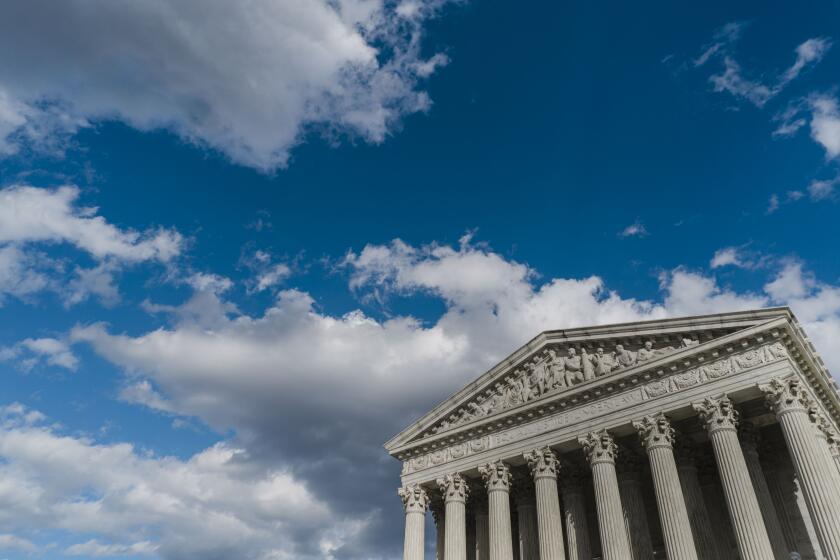The Supreme Court’s wise ruling on free speech and online threats

- Share via
The Supreme Court long has said that “true threats” are not protected by the 1st Amendment, but what is a true threat? Although the issue is not new, social media has exponentially increased instances of speech that is perceived as threatening.
Not surprisingly, courts in recent years have struggled with the question of how to determine what is a true threat that can be punished. On Tuesday, in Counterman vs. Colorado, the Supreme Court resolved this question and adopted a sensible compromise meant to both protect free speech and safeguard people from being threatened.
Over a half century ago, in United States vs. Watts, the Supreme Court held that true threats are speech unprotected by the 1st Amendment. Robert Watts, then 18, attended a rally and stated, “I have already received my draft classification as 1-A and I have got to report for my physical this Monday coming. I am not going. If they ever make me carry a rifle the first man I want to get in my sights is L.B.J.” Watts was arrested and convicted for violating a federal law that makes it a crime to “knowingly and willfully” threaten the life of the president.
The Supreme Court’s message to red states: You can’t sue just because you don’t like federal law
In a ruling Friday, the high court brought Texas and fellow states in line after a deluge of Republican lawsuits over immigration and other presidential policies, setting limits on the ability to sue.
The Supreme Court upheld the federal statute, but reversed Watts’ conviction. The court said true threats are unprotected by the 1st Amendment, but that they must be distinguished from speech that is just hyperbole. The court concluded that Watts’ statement was “political hyperbole.”
In subsequent cases, the court reaffirmed that true threats are not protected by the 1st Amendment, but it never articulated the standard for determining what constitutes a true threat.
Over the decades, the lower courts across the country have divided between two major approaches to defining what is a true threat. Some state and federal courts, including the Colorado Supreme Court in the Counterman case, said that it should be an objective test: Speech is unprotected if it would cause a reasonable person to feel threatened.
But other courts adopted a subjective approach, holding that to punish such speech there has to be a subjective intent on the part of the speaker to threaten. This is a much harder standard to meet because of the difficulty of proving a person’s intentions.
In Tuesday’s decision, the court devised a compromise and said that speech can be punished when the speaker was “reckless” if he “consciously disregarded a substantial risk that his communication would be viewed a threat of violence.” It rejected the subjective standard as not providing enough protection for safety and the objective standard as not doing enough to safeguard speech.
Supreme Court may make it harder to prosecute cyberstalking.
The case involved Billy Raymond Counterman, who for over two years sent hundreds of messages over Facebook to a singer, identified as C.W. Sometimes the messages were conversational about his life; sometimes they expressed anger towards C.W. She never responded and came to feel threatened and feared for her safety. C.W. filed a complaint with the police.
Counterman was prosecuted under a Colorado law that provides for criminal liability if speech “would cause a reasonable person to suffer serious emotional distress.” The Colorado Supreme Court previously had held that conviction requires proof only that the speaker “knowingly” make repeated communications and does not “require that a perpetrator be aware that his or her acts would cause a reasonable person to suffer serious emotional distress.” Counterman was convicted and sentenced to four and a half years in prison.
The Supreme Court, in a 7-2 majority opinion by Justice Elena Kagan, reversed the Colorado courts and sent the case back to apply the new legal standard: Was Counterman reckless in that he consciously disregarded a substantial risk that his communication would be perceived as a threat?
This is a sensible approach to addressing the issue of threatening messages, which pervades social media platforms. The justices found the right middle ground, balancing the need to protect people who fear for their safety against opening the door to more prosecutions for pure expression.
Erwin Chemerinsky is a contributing writer to Opinion and dean of the UC Berkeley School of Law. His latest book is “Worse Than Nothing: The Dangerous Fallacy of Originalism.”
More to Read
A cure for the common opinion
Get thought-provoking perspectives with our weekly newsletter.
You may occasionally receive promotional content from the Los Angeles Times.











